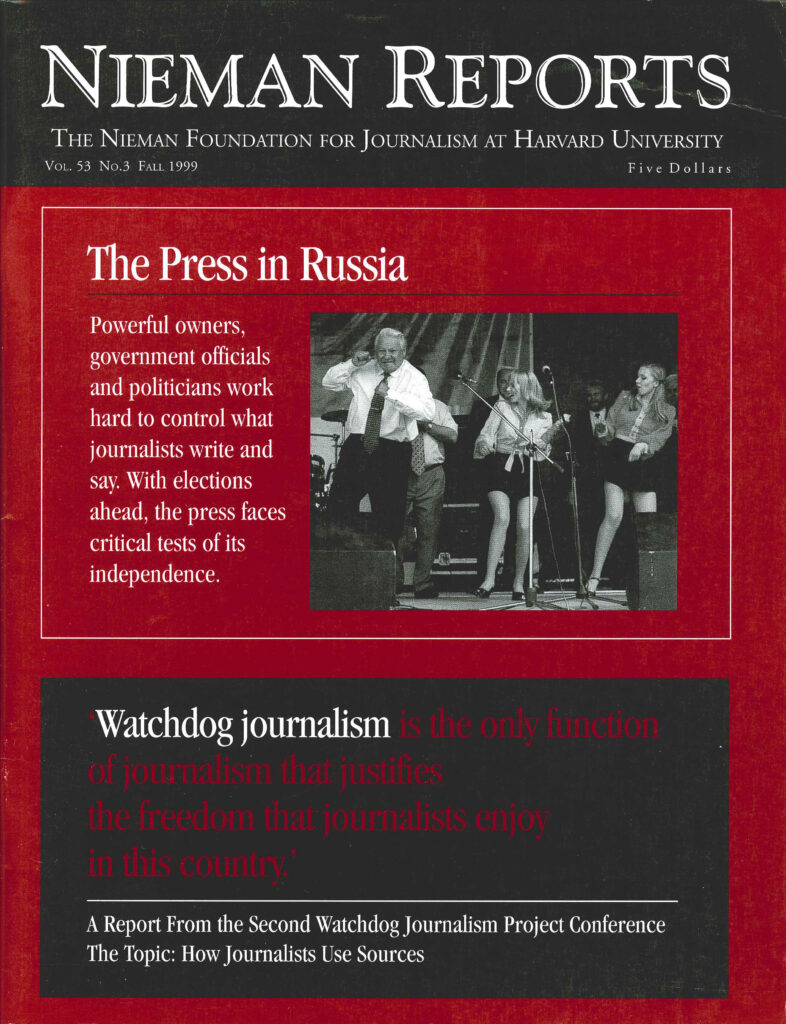In most reporting assignments—perhaps most often in journalists’ roles as watchdogs—following leads usually results in finding a key source, someone who can help to build the story’s foundation. How reporters work with these sources who often want, at least in the beginning, to reveal what they know in secret, was a topic of interest at the conference.
Alison Grant: “It became apparent after a while that my key source inside City Hall, who spoke to me only on background, was also helping the police. Without either of us ever naming the source, it was clear it was the same person. So for me, it was a way to check what I heard against what they heard…. I met this source in the women’s bathroom at City Hall after the first few stories were out. I had never noticed her before, and I didn’t know her name. Her only words to me then were, ‘You’re on the right track,’ and then she disappeared into a stall. It was like out of a movie.
“I began calling her at home, and she more than anyone told me where to look, what questions to ask, what records to get. We never met privately in person until after the investigation was over, by which time she had retired and we met just once for lunch. It was totally a relationship by telephone. I would see her at City Hall when I went there but we didn’t acknowledge each other…. Having contact with her by telephone made it pretty easy to maintain good independence. It was an arm’s length relationship to begin with, and since everything she told me was not for attribution, it had to be verified through documents and on-the-record interviews with other people.”
Susan Kelleher: “I think my first big break came when I found the former manager of the [infertility clinic] practice, and unbeknownst to me she was pretty freaked out at the time because the University had its own secret investigation. This is when it was trying to squeeze the doctors out. So she asked me a lot of questions about what I was doing, and I really got uncomfortable. It was like, I don’t know if I want to tell this woman the things that I’m looking at.
“Without compromising other sources, I did tell her. And over a period of probably about three weeks, she finally just cracked. We would meet at a park by her house where her kids would play soccer. And finally one day I had a single record that somebody had sent me anonymously in the mail, and I said, ‘Could you tell me what this means? I have no idea what this means. I know it involves this patient here.’ “So she said, ‘I don’t know why you keep pointing to that patient because there’s a lot of patients on there.’ I’m like, ‘What? I can’t even read this thing.’ Then she told me that there were hundreds of patients involved.”
Doug Frantz’s initial source for his Scientology stories was a private detective, Michael Shomers, who had been hired by the Church of Scientology to “dog several IRS officials.” His experiences and recollections were invaluable in shaping the story and leading Frantz to other sources, but his documentation was critical to being able to verify that what he was saying was accurate.
Doug Frantz: “Fortunately for me and for the readers of my newspaper, he [Shomers] had maintained copies of almost all of the documents he generated for the Church of Scientology. So here I had the perfect source, it seemed to me, to start this story. I had a guy who was willing to go on the record, who ultimately disclosed what his agenda was, and who had the documents to back up everything that he said. It was a wonderful find and the best possible way to begin that story…. The next batch of sources I dealt with really were the Scientology defectors…. Their motives were as suspect to me as those of any source or any official within the Church of Scientology because they clearly had an ax to grind. They had their own agenda. It was vitally important that I hear what they had to say and then that I be able to go out and corroborate that…. It’s a matter of using the sources as a beginning point and finding out what you can do to corroborate that information. For me, it was essential on that story. It’s that essential on every story.”
Alison Grant: “It became apparent after a while that my key source inside City Hall, who spoke to me only on background, was also helping the police. Without either of us ever naming the source, it was clear it was the same person. So for me, it was a way to check what I heard against what they heard…. I met this source in the women’s bathroom at City Hall after the first few stories were out. I had never noticed her before, and I didn’t know her name. Her only words to me then were, ‘You’re on the right track,’ and then she disappeared into a stall. It was like out of a movie.
“I began calling her at home, and she more than anyone told me where to look, what questions to ask, what records to get. We never met privately in person until after the investigation was over, by which time she had retired and we met just once for lunch. It was totally a relationship by telephone. I would see her at City Hall when I went there but we didn’t acknowledge each other…. Having contact with her by telephone made it pretty easy to maintain good independence. It was an arm’s length relationship to begin with, and since everything she told me was not for attribution, it had to be verified through documents and on-the-record interviews with other people.”
Susan Kelleher: “I think my first big break came when I found the former manager of the [infertility clinic] practice, and unbeknownst to me she was pretty freaked out at the time because the University had its own secret investigation. This is when it was trying to squeeze the doctors out. So she asked me a lot of questions about what I was doing, and I really got uncomfortable. It was like, I don’t know if I want to tell this woman the things that I’m looking at.
“Without compromising other sources, I did tell her. And over a period of probably about three weeks, she finally just cracked. We would meet at a park by her house where her kids would play soccer. And finally one day I had a single record that somebody had sent me anonymously in the mail, and I said, ‘Could you tell me what this means? I have no idea what this means. I know it involves this patient here.’ “So she said, ‘I don’t know why you keep pointing to that patient because there’s a lot of patients on there.’ I’m like, ‘What? I can’t even read this thing.’ Then she told me that there were hundreds of patients involved.”
Doug Frantz’s initial source for his Scientology stories was a private detective, Michael Shomers, who had been hired by the Church of Scientology to “dog several IRS officials.” His experiences and recollections were invaluable in shaping the story and leading Frantz to other sources, but his documentation was critical to being able to verify that what he was saying was accurate.
Doug Frantz: “Fortunately for me and for the readers of my newspaper, he [Shomers] had maintained copies of almost all of the documents he generated for the Church of Scientology. So here I had the perfect source, it seemed to me, to start this story. I had a guy who was willing to go on the record, who ultimately disclosed what his agenda was, and who had the documents to back up everything that he said. It was a wonderful find and the best possible way to begin that story…. The next batch of sources I dealt with really were the Scientology defectors…. Their motives were as suspect to me as those of any source or any official within the Church of Scientology because they clearly had an ax to grind. They had their own agenda. It was vitally important that I hear what they had to say and then that I be able to go out and corroborate that…. It’s a matter of using the sources as a beginning point and finding out what you can do to corroborate that information. For me, it was essential on that story. It’s that essential on every story.”



